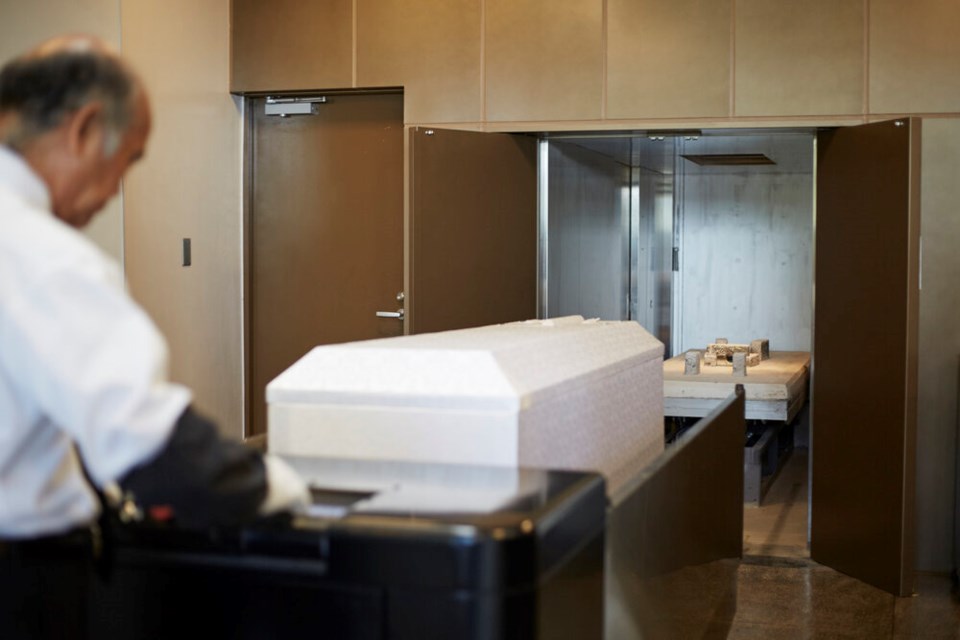Inside a cremation chamber, the first part of a human body to go up in flames is the hair. At 100 degrees Celsius, water, and therefore human blood, boils.
As the temperature climbs, organs start to vaporize, and at 357 C, the elemental mercury in teeth fillings goes airborne, climbing out of crematoria stacks and contributing at least seven per cent of atmospheric mercury to B.C.’s air sheds.
At 760 C, most organic compounds burn off, with each cremation releasing hundreds of kilograms of carbon dioxide and particulate matter into the atmosphere.
It’s a quiet process that plays out over 35,000 times in British Columbia every year. With nearly 90 per cent of all deaths in the province consigned to cremation, B.C. is the most popular Canadian jurisdiction to lay a body to rest by flame.
How much atmospheric carbon is released from a single human cremation ranges widely, though on average, the process is thought to release the carbon equivalent of an average passenger vehicle burning two tanks of gasoline.
Scale that up across the province, and cremation is believed to release somewhere around 10 million kilograms of carbon every year in B.C., enough to drive that same gas-powered vehicle upwards of 1,000 times around Earth's equator.
Ashes family scatter at sea, bury in the earth or place on a mantel are only part of what cremation leaves behind. And some worry the practice is out of sync with a world grappling to reduce carbon emissions.
“Up until 10 years ago, cremation was considered the lesser of two evils,” said Joseph Dolan of West Shore Crematorium on Vancouver Island.
Now, he added, “people have been waking up to the fact that it’s not as green as it was thought to be.”
A RACE TO THE BOTTOM
Emily Bootle used to work as a funeral home director and embalmer for Service Corporation International (SCI), a U.S.-based corporation that owns seven cemeteries and 36 funeral services in B.C., including several of the province’s 51 crematoria.
As companies like SCI and Toronto-based Arbor Memorial were scooping up funeral homes and crematoria across Canada, she says she became jaded with an industry locked in a race to offer the cheapest cremation services possible.
In at least one case, the Vancouver-registered company Amherst Funeral & Cremation Services Inc. has turned to send B.C.’s dead out of the country to get cremated.
One Metro Vancouver resident whose family recently contracted Amherst told Glacier Media he was surprised to discover the box containing the ashes of his recently deceased mother had made a trip all the way from Blaine, Washington.
“It was just a big red flag,” the man said, who asked not to be named to avoid traumatizing his family.
Amherst founder and operator Scott McFarlane said working across the border allows the company to offer cheaper and faster cremation services. He said his operation has always been transparent about cremating in U.S., where it owns a stake in the Blaine crematorium and therefore has greater control over its operating standards.
Amherst places detailed disclosures in three places throughout client paperwork, according to the funeral home director, who added anyone can choose to have a cremation occur at a B.C. facility instead.
When asked whether cremating in Washington was the company’s way of avoiding B.C.’s carbon tax, McFarlane described the claim as “absolutely false.”
“This is one of many lies often used by our competitors to take a cheap shot at our well-established operations,” he said.
Crematoria in B.C. are subject to the province's carbon tax. But the levy only applies to fuel purchased or used in B.C. Cremations that occur outside of the province — such as Washington State — are subject to the taxes within that jurisdiction, confirmed a spokesperson for the B.C. Ministry of Environment and Climate Change Strategy.
“The carbon tax is a robust policy tool to reduce (greenhouse gas) emissions across sectors including in the end-of-life industry,” wrote the spokesperson.
That answer hasn’t satisfied Bootle, who also serves as vice-president for the Green Burial Society of Canada.
“The response we get is that the carbon tax looks after the emissions from cremation and just none of the narrative of ‘the foot off the gas or keeping things out of the air,’” said Bootle. “It's just... ‘that will take care of it for your industry, so don't worry about it.’”
After Bootle left SCI, she joined KORU Grassroots Deathcare as a way of offering British Columbians an alternative in death. The women-led funeral home is part of a growing movement of small-scale death services trying to transform the industry to accept more environmentally friendly options.
Cremation and burial are the only two legal options to dispose of human remains in B.C. For those seeking cremation, KORU sends all the bodies they handle to the West Shore Crematory on Vancouver Island, which was recently built in Langford to the highest efficiency standards possible.
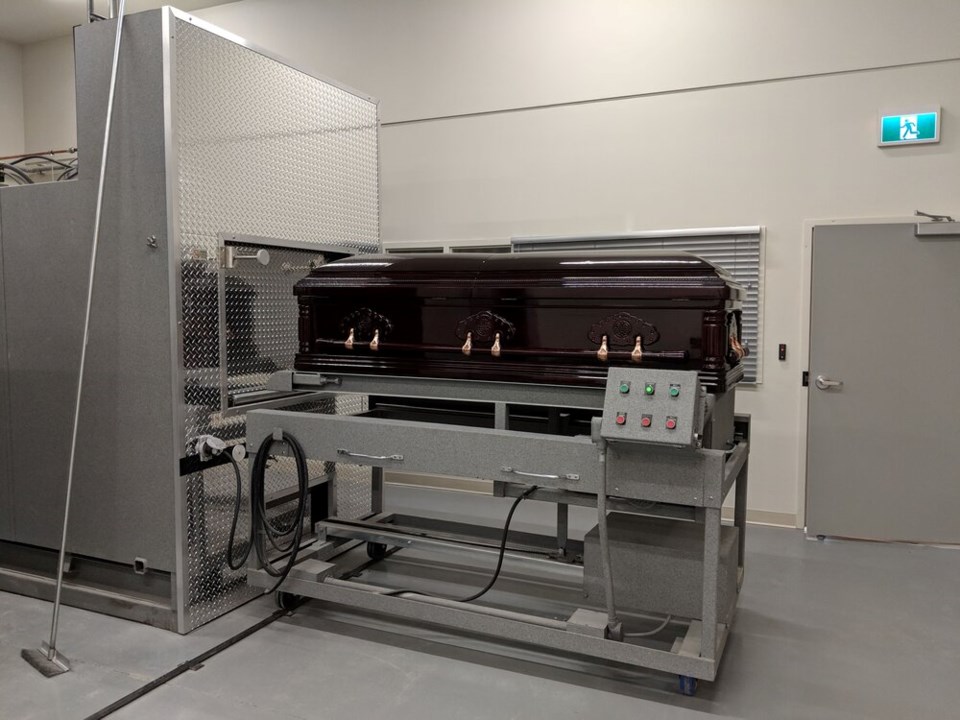
But shipping bodies every week on a ferry to get cremated is not an ideal solution.
Some advocates pushing for sustainable alternatives say the end-of-life industry has been hamstrung by large corporate crematoria owners who have no interest in changing the status quo.
Others point to an anachronistic system regulating death in B.C. that has failed to change with the times.
Whatever the case, if cremation remains the de-facto practice of laying the dead to rest, the industry's emission levels are only set to climb.
“When you look at our population boom and the death rate increase that's going to accompany the aging baby boomers, the carbon footprint of cremating that generation is going to be huge,” warned Bootle.
RISING EMISSIONS FROM THE DEAD
Some estimates suggest cremation in B.C. released roughly one and half times the greenhouse gas emissions produced by all of B.C.’s propane and natural gas vehicles in 2019. But it’s not just carbon emissions that have some concerned.
The impacts of vaporized mercury, particulate matter, and dioxins and furans released during cremation are not totally clear. Each is toxic to life in its own way.
Mercury exposure is most commonly associated with bioaccumulation in the food chain, such as big fish eats little fish, then human eats too much canned tuna.
In the workplace, exposure to mercury vapour has been linked to chest pains, coughing and in some cases death due to pneumonitis.
But there are few studies measuring the impact of crematoria-produced toxic pollutants on human health. One study stretching from 1956 to 1993 found the risk of stillbirth and anencephalus — a birth defect where children are born without parts of their brain and skull — went up for people living near crematoria, though the study didn’t account for industrial pollutants and no direct link was found.
“That’s the only study that has gone looking to health effects of residential areas living near crematoria,” said Juliette O’Keeffe, an environmental health and knowledge transfer scientist with the BC Centre for Disease Control.
More recently, Metro Vancouver and researchers at the University of British Columbia have found no evidence that mercury vapour poses a significant risk to human health in B.C.
A Metro Vancouver regional risk assessment found diesel particulate matter was a much bigger concern than toxic air pollutants like mercury, a spokesperson for the regional body confirmed.
At the same time, UBC researchers warned that because many Canadian jurisdictions fail to systematically measure crematoria emissions, there are big blind spots in the data.
“If the number of cremations increases, it might reach considerable levels, highlighting the need for developing a national plan similar to other countries,” concluded the 2020 study.
Bootle says cremating a body in a modern casket can emit a variety of pollutants — from the lacquers and glues in the particleboard to the clothing and keepsakes that are often burned with the human remains.
But as B.C.’s population ages, there is little appetite to build new crematoriums to keep up with demand. The crematorium KORU uses only built its facility in Langford after it was blocked from operating in Metro Vancouver due to municipal pushback.
“Nobody wants a flame crematorium in their backyard, but you don't really blame them. There's a lot of stuff that comes out of those,” said Bootle. “There are more sustainable alternatives that are not being made available to us during this crucial time when we have the space to build infrastructure for managing our dead.”
“We’re just not doing it because of a lack of political appetite.”
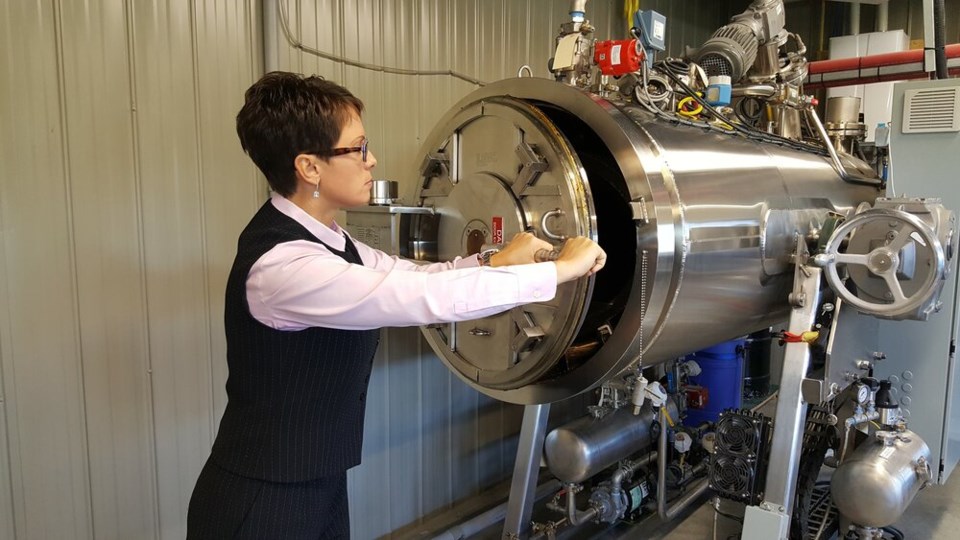
WATER CREMATION — GOOD ENOUGH FOR AN ARCHBISHOP
In 2013, KORU was among seven funeral homes in B.C. that began petitioning Consumer Protection BC (CPBC) to expand the legal options to lay to rest the dead.
(In addition to overseeing death services in the province, CPBC regulates payday lending, telemarketing and even overseeing the sale of adult videos.)
After what the group describes as “pushback,” Chris Benesch, funeral director and owner of Earth's Options Cremation and Burial Services in Esquimalt, B.C., made an official application to the province to amend current cremation laws in 2017.
As part of the coalition, Earth’s Option called for the province to legalize alkaline hydrolysis — popularly known as “aquamation” — a flameless cremation technique that produces an estimated one-tenth the emissions of traditional cremation.
Aquamation combines alkali chemicals and water in a heated, often pressurized chamber to accelerate decomposition. After a few hours, the water-based cremation technique reduces the human body to a skeleton and inert effluence that can be sent into any municipal wastewater system without special treatment.
“It’s biodegradable, of course. It looks like a cup of tea,” said Benesch.
Family members are left with the same portable remains for a similar cost as flame-based cremation, but with a fraction of the emissions.
“There's nothing glamorous about death care no matter how you look at it,” he said. “Is it better to have your loved one in a hot bath that dissolves them, or a hot fire that burns them, or a grave that decomposes them?”
“That’s subject to the beholder, I guess.”
First used in 1995 to manage human remains donated to science, it has gained a global following in recent years as an environmentally friendly way to lay the dead to rest. When famed Archbishop Desmond Tutu died last December, it emerged that the anti-apartheid leader had chosen to be aquamated.
Benesch, whose family has been in the funeral business for 60 years, says the surge in popularity that came to flame-based cremation after the Catholic Church loosened its stance on the practice is set to repeat itself. Only this time, instead of religion driving the change, a concern for individuals’ environmental footprint — even in death — is pushing people to explore more options.
Other organizations, including the British Columbia Women’s Institute, have joined the campaign to legalize the technology.
But despite its image as a progressive province, B.C. is falling behind several Canadian and U.S. jurisdictions. So far, the Northwest Territories and four provinces — Saskatchewan, Ontario, Quebec and Newfoundland and Labrador— have made aquamation legal. In the U.S., it's legal in 22 states.
After nearly a decade of lobbying, Benesch says he’s seeing signs from Solicitor General Mike Farnworth’s office that the government will move ahead to overhaul the Cremation, Interment and Funeral Services Act over the next 18 months.
A spokesperson for the Ministry of Environment and Climate Change Strategy said the province “fully supports the development and use of new technology to reduce emissions and has been reviewing options to do so in the end-of-life industry.”
Before the provincial government makes changes to legislation to allow for aquamation, added the spokesperson, it needs to assess a variety of concerns, from local government zoning, operator training and licensing, and worker safety to consumer protection, the respectful handling of human remains, and public health.
Even crematorium operators like Amherst's McFarlane see the potential in aquation should it become legal in B.C.
“If this is what consumers want and it gives us a chance to own our operation truly locally, why not?” he said.
Benesch, for his part, says his funeral home is ready to make space for the device, and while they cost upwards of $300,000, the business plan is to charge about $100 less for water cremation to push people away from fossil fuels.
“It’s not like government would be saying this aquamation replaces flame cremation — it’s simply an additional option that people can choose,” he said, recognizing flame cremation is both culturally and religiously important for many of B.C.’s Buddhist, Sikh and Hindu residents, among others.
Until then, neighbouring jurisdictions with more progressive death legislation could fill the void.
“There's enough interest that we have looked into what it would be like to set up one of those facilities in Blaine and then drive our people across the border,” said Bootle.
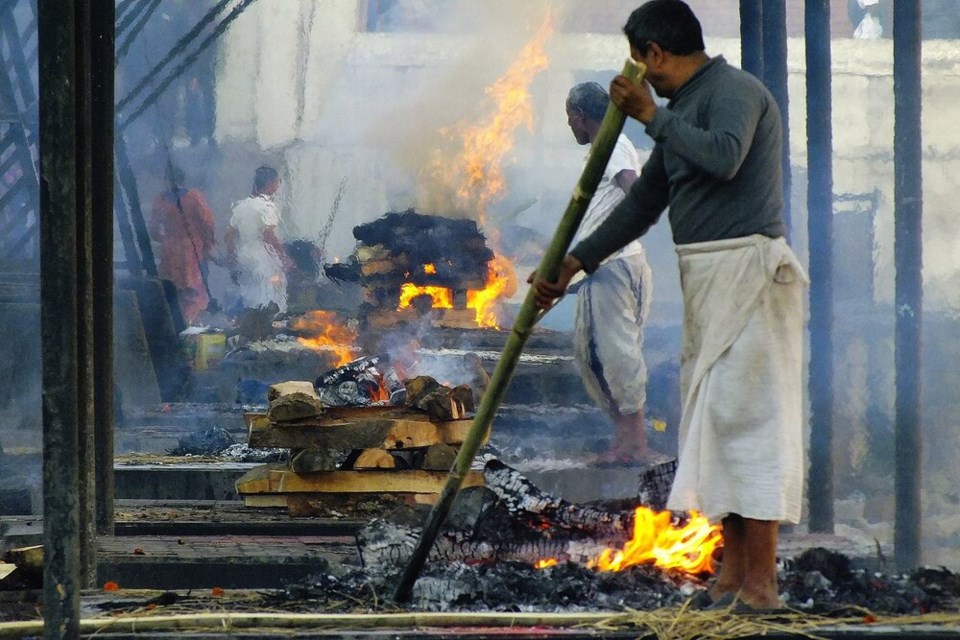
HUMAN COMPOSTING COMES TO CANADA
As B.C. considers legal reform on aquamation, its neighbour to the south has emerged as a global leader in alternative death services.
In 2019, Washington State amended its laws governing the disposition of human remains. And while that’s opened the door to aquamation, others are turning to the earth to accelerate decomposition.
Today, two companies, Recompose and Return Home, offer terramation or “human composting” services at facilities near Seattle.
In January of this year, Return Home became the first to accept Canadian bodies at its 11,500-square-foot industrial facility in Auburn, Washington.
When an individual dies, their body is transported to the warehouse, where it’s placed in one of 74 vessels.
From the outside, the vessels are stacked in racks three layers high, each one looking like a large chest freezer. Inside, a human body is laid to rest with a mix of alfalfa, straw and sawdust.
“After we get those ingredients in there, the microbes in our body take over,” said operations manager Steve Calson.
For roughly 60 days, the vessel maintains the right combination of moisture, airflow and temperature. Odours and water vapour are sucked out through an HVAC system.
Family members come in and sit with their relatives on a regular basis. One mother whose 36-year-old son passed away recently came in on a Saturday to celebrate his birthday with balloons and cupcakes.
Some deceased veterans have flags draped over them. Some family members decorate and doodle on the vessel.
Others just come and sit as their loved one turns into soil.
“People come in and do what they need to do,” said Brie Smith, the company’s service director.
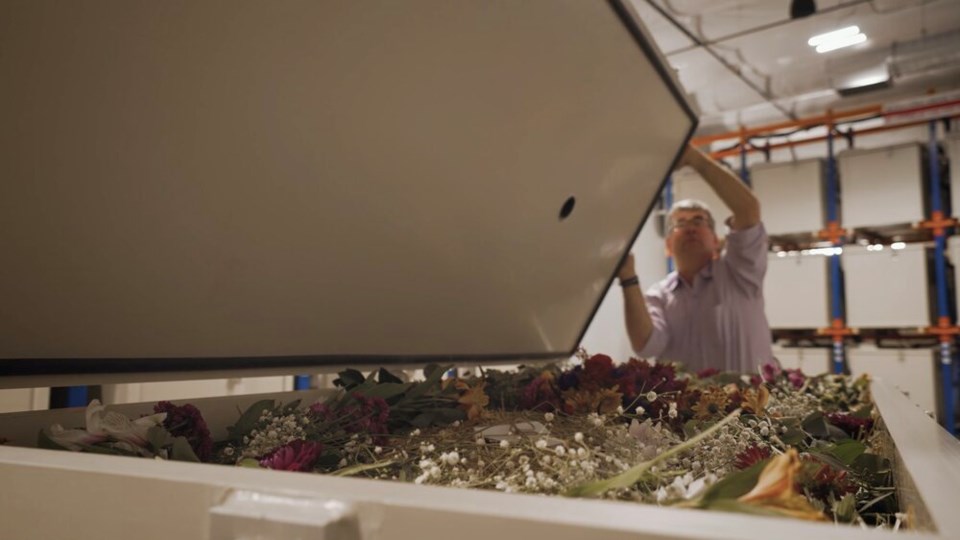
In the end, the vessel is opened; metal hips, rods and fillings are removed; the bones and teeth are sifted, crushed and mixed into the newly formed earth in a process that stimulates an ecosystem of healthy microbes.
“At the end, it’s really about 500 pounds of compost,” said Calson, who came to Return Home after abandoning a career supplying plastic parts to companies like Boeing and the U.S. Department of Defence.
Some families decide to take the soil home and build a retaining wall to protect their house from wind, or use it to nourish a garden.
But like cremation, the process also allows loved ones detached from a multi-generational patch of land to maintain a portable memorial; like aquamation, it only produces about a tenth of the emissions produced when a body is burned.
“It used to be people stayed in the same place for life. But many people are moving and shifting these days. This lets them have something tangible and accessible,” said Smith.
When a family can’t handle that large volume of soil, Return Home scatters what's left on a dedicated acre of green space near a trail.
The company, which has plans to expand in Oregon and Colorado, says it’s also eying places like British Columbia should it ever pass laws to make their operation legal.
“We want to get to Canada, but the laws have to be passed first,” said Smith. “It’s the fact that we’re not local is what holds people up internationally.”
Until then, they continue to work with a number of funeral homes in B.C., and as COVID-19 restrictions ease, are waiting for their first Canadian family to choose human composting.
While companies like Return Home look to new technologies and techniques to decarbonize death, others are looking closer to home.
A 'RADICAL' PROPOSAL — BURY DEAD TO PROTECT LAND
When Catherine Valentine landed on Salt Spring Island, the plan was to turn the old Funk Farm into something sustainable. Over the past nine years, Valentine and her biologist husband have turned the farm’s 84 acres of land into a productive egg and cattle operation.
At the same time, Valentine says they have slowly planted new trees, established new wetlands and worked to establish the farm as a sanctuary for wildlife.
The couple’s vision for the land doesn't end at their death. Instead, they foresee the land passing to their children as a legacy farm or to the community to be put into trust.
But while 70 acres of the land have been protected under Agriculture Land Reserve designation for generations, the other 14 acres on a nearby forested hillside remained vulnerable to subdivision and development.
When one summer day in 2018 a neighbour casually said he’d like to be buried on his land, it sparked something in Valentine. Once someone is buried on a piece of land, it should be protected under law forever, she thought.
Valentine started digging through what it would take to start a cemetery. She hired a geotechnical expert to assess whether the forested lot was suitable for burial — it was.
She submitted all the paperwork, and in the fall of 2020, the Salt Spring Island Natural Burial Cemetery became the first all green burial cemetery in B.C. open to the public.
Visitors to a modern cemetery will often find a relatively level landscape. That’s often the result of vast sums of concrete poured into the ground to keep the surface from collapsing. Underground, often bronze- or plexiglass-lined coffins, and the embalmed bodies inside, struggle to decompose. Industry experts say all that adds up to even more emissions than cremation.
Green burial, on the other hand, relies on simple plank boxes or shrouds, in line with the traditional burials still practiced by people following Jewish or Muslim tradition.
Those buried at the Salt Spring Island cemetery are placed in the earth with little more than a human-sized wicker basket and a shroud.
In the roughly 18 months that they have been open, a number of people have purchased a right of interment at a cost of $4,500.
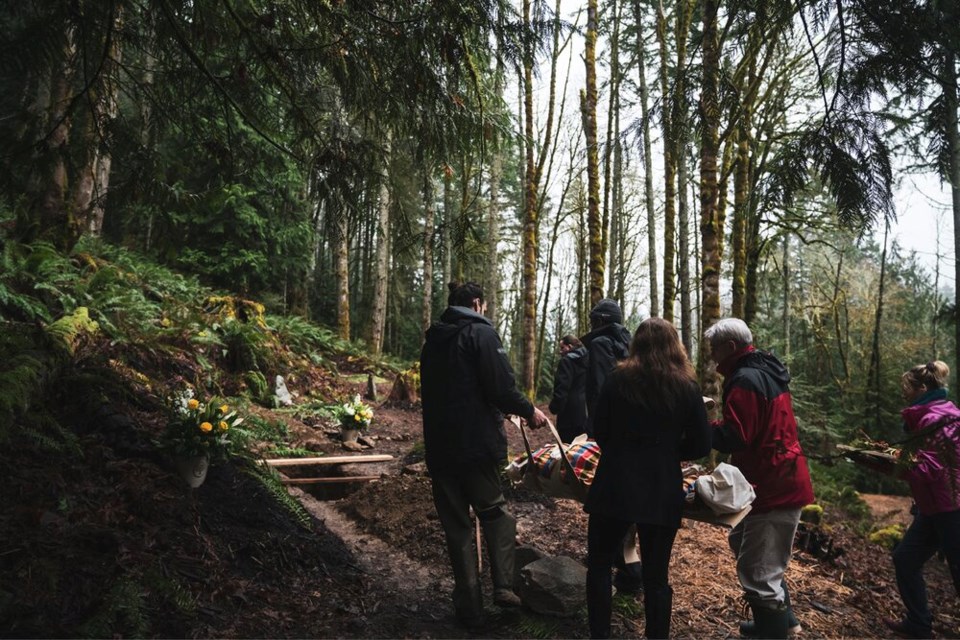
Last week, the latest person to be laid to rest came from a neighbouring island — a man who had passed away after a stint in palliative care.
The ceremony started with an outdoor potluck under the Douglas fir forest that makes up the cemetery. An hour later, the body arrived with the funeral director, laid out on a wicker tray and shrouded in a red cotton sheet picked up at Value Village the day before. A horsehair blanket was draped over top.
Roughly 30 attendees stood in a circle with the man's body as friends and family shared stories. From there, a procession led up the hill to the burial ground. An accordion wheezed the notes to Hallelujah as they climbed.
Lowered into the grave, each person added their own shovel or handful of earth to say goodbye.
“It was beautiful,” said Valentine. “The rituals of Christianity carried us for a long time. And for many of us, they no longer serve.”
“But what struck me yesterday is… we know how to do this and how to do this well.”
At the same time, the man’s body, along with the remains of others buried there, create a covenant that will ostensibly protect the land in perpetuity. It’s a strategy Bootle agrees holds vast potential for protecting natural spaces across B.C.
“As you put one body in that ground, it’s not to be used for any other purpose,” said the vice-president of the Green Burial Society of Canada.
“This is obviously something that came about more recently in Canadian history because First Nations burial sites are not provided the same courtesy. But with our contemporary land use, it's actually quite radical.”
Or as Valentine put it, “we’re feeding the forest.”
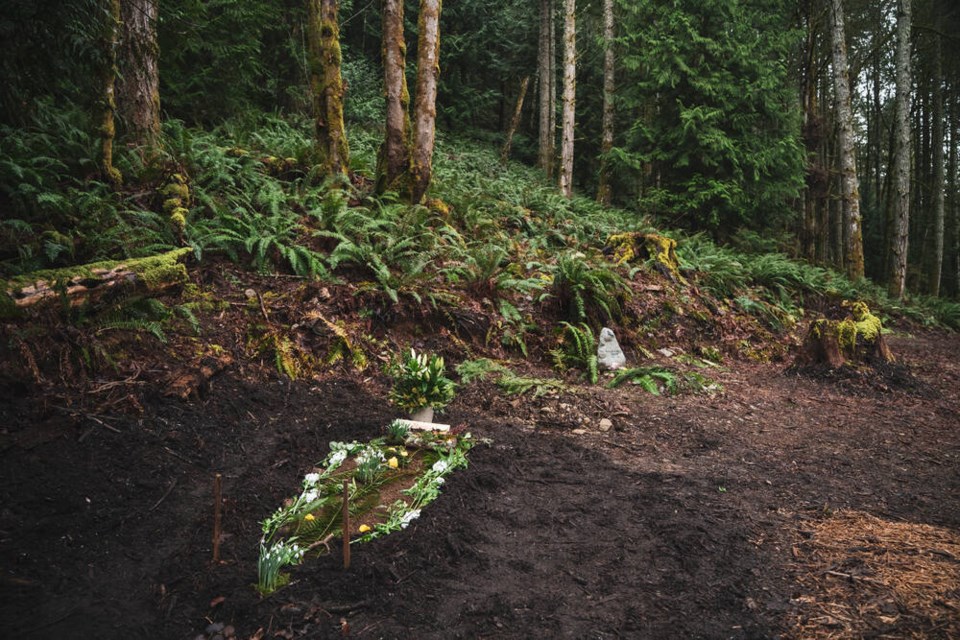
Cast your sights across the globe and you’ll find a number of alternatives to deal with the dead.
In Sweden, a process called promession cryogenically freezes the body in liquid nitrogen before it is vibrated into fine particles. In Ladysmith, B.C., one company offers to turn cremated ashes into a living reef.
But according to Benesch, there’s no silver bullet to reduce death’s carbon footprint. He says the best chance to decarbonize the industry will come from some combination of green burial, human composting and aquamation.
For some British Columbians, it will come down to personal preference. For many others, cost will be the deciding factor — green burial at the Salt Spring Island cemetery is more than triple the price Benesch plans to charge to aquamate a body.
Whatever the case, the twin pressures of an aging population and a drive to reduce emissions across every sector are set to transform the death-care industry.
“It’s not a glamorous subject,” said Benesch. “It’s one of those things that is real, it's happening and we have to talk about it.”
Stefan Labbé is a solutions journalist. That means he covers how people are responding to problems linked to climate change — from housing to energy and everything in between. Have a story idea? Get in touch. Email [email protected].
Video: Alanna Kelly

